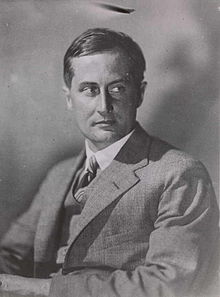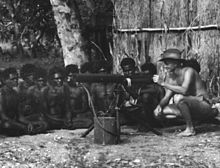| Donald Thomson, OBE | |
|---|---|
 Donald Thomson Donald Thomson | |
| Born | 26 June 1901 Brighton, Victoria |
| Died | 12 May 1970 (1970-05-13) (aged 68) Melbourne |
| Nationality | Australian |
| Alma mater | University of Melbourne University of Sydney |
| Known for | Ethnographic records made of: i. Wik-Mungknh people ii. Yolngu people iii. Pintupi people |
| Scientific career | |
| Fields | Aboriginal Australian anthropology |
| Institutions | University of Melbourne |
| Academic advisors | Alfred Radcliffe-Brown |

Donald Finlay Fergusson Thomson OBE (26 June 1901 – 12 May 1970) was an Australian anthropologist and ornithologist. he is known for his studies of and friendship with the Pintupi and Yolngu peoples, and for his intervention in the Caledon Bay crisis.
Early life and education
Donald Finlay Fergusson Thomson was born on 26 June 1901 in the Melbourne suburb of Brighton.
Thomson went to Scotch College, Melbourne, before earning a B.Sc. in zoology and botany at the University of Melbourne in 1925. In 1927 he studied at the University of Sydney, earning a diploma in anthropology in 1928.
While still a school student, he joined the Royal Australasian Ornithologists Union in 1917. He served as press officer in 1923, and then as assistant editor of its journal, Emu from 1924 to 1925.
After two trips to Cape York, Queensland, Thomson joined the Walter and Eliza Hall Institute of Medical Research in Melbourne, and in 1932 joined the University of Melbourne as a research fellow, obtaining his PhD in 1934.
Career
When he graduated in 1925 he joined the Melbourne Herald as a cadet. After earning his diploma in anthropology in 1928, he set off on an eight-month journey, working with and recording the Indigenous people of Cape York. On his return, he was falsely accused of dishonesty, because of the loss of some funds, which was later traced to fraudulent activity by a staff member of the Australian Research Council. This unhappy episode forever damaged his relationship with other anthropologists at Sydney.
Thomson lived at the property of Worlingworth, Eltham from the 1930s. The c.1922 residence and surrounding farm site is considered historically significant and is listed on the Victorian Heritage Databases because of its association with Thomson.
Caledon Bay crisis (1932–3)
Main article: Caledon Bay crisisIn 1932–33, as the Caledon Bay crisis erupted, Thomson offered his services to the Australian Government to resolve the crisis, and to the surprise of the government succeeded in doing so. His success had long-term ramifications for the relationship between Indigenous and non-Indigenous Australians, and is regarded as the crowning achievement of his life.

He formed a strong bond with the Yolngu people, studying their traditional use of the land in the Arafura Swamp and elsewhere. The story of Thomson's interactions with the northern Arnhem Land Ramingining people is told through the eyes of the Indigenous people in Rolf de Heer's 2009 film Twelve Canoes.
In 1941, he persuaded the Army to establish a special reconnaissance force of Yolngu men known as the Northern Territory Special Reconnaissance Unit, including tribal elder Wonggu and his sons, to help repel Japanese raids on the northern coastline of Australia. In 1943, as the war moved northward from the Australian coast, the unit was disbanded, and Thomson returned to the Air Force. He was badly injured in action in Dutch New Guinea, and spent the rest of the war in hospital before being discharged from the Armed Forces.
In central Australia (1957)
Main article: Bindibu ExpeditionIn 1957, Thomson carried out the "Bindibu (Pintupi) Expedition" to the Western Desert to make contact with Pintupi there. For some Pintupi, this was their first contact with Europeans. They were almost the last Indigenous Australian group with whom white Australians were to make contact (the very last was a group of Pintupi in 1984). Thomson again demonstrated his excellent ethnographic skills. The photographs taken here, like those he took in the 1930s in Arnhem Land, have become invaluable historical records for Aboriginal and non-Aboriginal Australians, particularly for the Pintupi. Thomson lived with the Pintupi, and liked them, through much of the 1950s and the 1960s.
Later life, death and legacy
He returned to the University of Melbourne and continued working there until his death on 12 May 1970. His ashes were flown to the Northern Territory and, accompanied in the plane by two of the sons of Wonggu, scattered over the waters of Caledon Bay.
The Thomson Collection, which is currently held by Museums Victoria, includes approximately 4000 black and white glass plate photographs. One of these photographs was of a group of ten men in their bark canoes on a swamp, and was the inspiration for the title of a critically acclaimed film Ten Canoes. The title of the film arose from discussions between co-director Rolf de Heer and the film's narrator, David Gulpilil, about a photograph of ten canoeists poling across the Arafura Swamp, taken by Thomson in 1936.
Thomson is remembered as a friend of the Yolngu people, and as a champion of understanding, by non-Indigenous Australians, of the culture and society of Indigenous Australians. He was largely responsible for turning the Caledon Bay crisis into a "decisive moment in the history of Aboriginal-European relations".
Thomson's story is tolde in an episode in the 2013 documentary television series Desperate Measures, called "Donald Thomson with Agnes Waramba". As of 2023 the series is available on SBS on Demand.
In 2024, the Donald Thomson Ethnohistory Collection was gifted to the University of Melbourne by his family. It is UNESCO-inscribed.
Personal life
Thomson married, first, Gladys Winifred Coleman, on 30 December 1925. They had two sons, before divorcing in 1954.
On 7 May 1955 he married Dorita Maria McColl, a 25-year-old technical assistant.
List of works
- Thomson, D. (1935). Birds of Cape York Peninsula. Ecological notes, field observations, and catalogue of specimens collected on three expeditions to north Queensland. Government Printer, Melbourne.
- Thomson, D.; & Peterson, N. (1983). Donald Thomson in Arnhem Land. Currey O'Neil, South Yarra., ISBN 0-859-02097-5
- Thomson D. (1975). Bindibu Country. Melbourne, Thomas Nelson, ISBN 0-17-005049-1
References
- ^ Morphy, Howard (1 January 2002). "Thomson, Donald Finlay Fergusson (1901–1970)". Australian Dictionary of Biography. Retrieved 12 February 2023.
This article was published in hardcopy in Australian Dictionary of Biography, Volume 16, (Melbourne University Press), 2002
- "Victorian Heritage Database". vhd.heritage.vic.gov.au. Retrieved 3 July 2021.
- Thomson, Donald, Donald Thomson in Arnhem Land, The Miegunyah Press, Melbourne, 2006 (reprint)
- "Twelve Canoes". Ronin Films. Retrieved 13 July 2019. Includes link to study guide PDF.
- McEvey, A.R. (1971). Obituary. Donald Fergusson Thomson. Emu 71: 88 (See: http://www.publish.csiro.au/?act=view_file&file_id=MU971088.pdf )
- "Long Synopsis" (PDF). Archived from the original (PDF) on 17 March 2018. Retrieved 24 August 2010.
- "Donald Thomson with Agnes Waramba (2013) - The Screen Guide". Screen Australia. 16 March 2018. Retrieved 12 February 2023.
- Desperate Measures on SBS on Demand.
- Patterson, Jack (9 December 2024). "Thomson family donates one of the largest collections of Aboriginal cultural heritage to University of Melbourne". Newsroom. Retrieved 11 December 2024.
Further reading
- Thomson, David (1992). NTSRU, 1941–1943: Northern Territory Special Reconnaissance Unit. Nhulunbuy, Northern Territory: Yirrkala Literature Production Centre. ISBN 0864093055.
External links
| External image | |
|---|---|
- Reconciliation: the First Act (ATSIC News, 1983.
- Donald F Thomson (Excerpts from various sources)
- 1901 births
- 1970 deaths
- Australian indigenous rights activists
- Australian anthropologists
- Australian ornithologists
- Australian Officers of the Order of the British Empire
- WEHI alumni
- Arnhem Land
- 20th-century Australian zoologists
- 20th-century anthropologists
- People from Brighton, Victoria
- Scientists from Melbourne
- University of Melbourne alumni
- University of Sydney alumni
- Academic staff of the University of Melbourne
- Australian people of Scottish descent